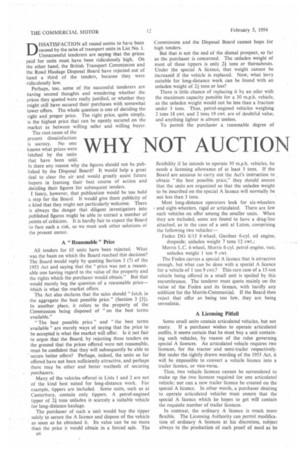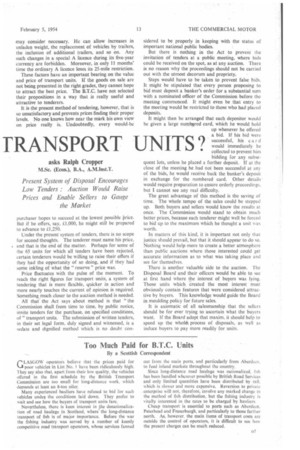WHY NOT AUCTION TRANSPORT UNITS?
Page 46

Page 47

If you've noticed an error in this article please click here to report it so we can fix it.
asks Ralph Cropper M.Sc. (Econ.), B.A., A.M.Inst.T.
Present System of Disposal Encourages Low Tenders : Auction Would Raise Prices and Enable Sellers to Gauge the Market
DISSATISFACTION all round seems to have been caused by the sales of transport units in List No. 1. Unsuccessful tenderers are saying that the prices paid for units must have been ridiculously high. On the other hand, the British Transport Commission and
the Road Haulage Disposal Board have rejected out of hand a third of the tenders, because they were ridiculously low. Perhaps, too, some of the successful tenderers are having second thoughts and wondering whether the prices they quoted were really justified, or whether they might still have secured their purchases with somewhat lower offers. The whole question is one of deciding the right and proper price. The right price, quite simply, is the highest price that can he openly secured on the market as between willing seller and willing buyer.
The root cause of the present dissatisfaction is secrecy. No one knows what prices were fetched by the units that have been sold. Is there any reason why the figures should not be .published by the Disposal Board? It would help a great deal to clear the air and would greatly assist future buyers in framing their best course of action and deciding their figures for subsequent tenders. I fancy, however, that publication would be too bold a step for the Board. It would give them publicity of a kind that they might not particularly welcome. There is always the danger that diligent investigators into published figures might be able to extract a number of points of criticism. It is hardly fair to expect the Board to face such a risk, so we must seek other solutions of the present unrest.
A " Reasonable " Price
All tenders for 65 units have been rejected. What was the basis on which the Board reached this decision? The Board would reply by quoting Section 3 (7) of the 1953 Act and saying that the "price was not a reasonable one having regard to the value of the property and the rights which the purchaser would obtain." But that would merely beg the question of a reasonable price— which is what the market offers.
The Act also declares that the sales should "fetch in the aggregate the best possible price" (Section 3 [3]). In another place, it refers to the property of the Commission being disposed of "on the best terms available."
"The best possible price" and "the best terms available" are merely ways of saying that the price to be accepted is what the market will offer. Is it not fair to argue that the Board, by rejecting these tenders on the ground that the prices offered were not reasonable, must be confident that they will subsequently be able to secure better offers? Perhaps, indeed, the units so far offered have not been sufficiently attractive, and perhaps there may be other and better methods of securing purchasers.
Many of the vehicles offered in Lists 1 and 2 are not of the kind best suited for long-distance work. For example, tippers are included. Some units, such as at
Canterbury, contain only tippers. A petrol-engined tipper of 21 tons unladen is scarcely a suitable vehicle for long-distance haulage.
The purchaser of such a unit would buy the tipper solely to secure the A licence and dispose of the vehicle as soon as he obtained it. Its value can be no more than the price it would obtain in a forced sale. The Commission and the Disposal Board cannot hope for high tenders.
But that is not the end of the dismal prospect, so far as the purchaser is concerned. The unladen weight of most of these tippers is only ,2i tons or thereabouts. Under the special A licence, that weight cannot be increased if the vehicle is replaced. Now, what lorry suitable for long-distance work can be found with an unladen weight of 24 tons or less?
There is little chance of replacing it by an oiler with the maximum capacity possible for a 30 m.p.h. vehicle, as the unladen weight would not be less than a fraction under 3 tons. Thus, petrol-engined vehicles weighing 2 tons 18 cwt. and 2 tons 19 cwt. are of doubtful value, and anything lighter is almost useless.
To permit the purchaser a reasonable degree of flexibility if he intends to operate 30 m.p.h. vehicles, he needs a licensing allowance of at least 3 tons. If the Board are anxious to carry out the Act's instruction to obtain "the best possible price," they should ensure that the units are organized so that the unladen weight to be inscribed on the special A licence will normally be not less than 3 tons.
Most long-distance operators look for six-wheelers • and eight-wheelers, rigid or articulated. There are few such vehicles on offer among the smaller units. When they are included, some are found to have a drag-line attached, as in the case of a unit at Luton, comprising the following two vehicles: Foden DG 6/15 8-wheel, Gardner 6-cyl. oil engine, dropside; unladen weight 7 tons 12 cwt.; Morris L.C. 4-wheel, Morris 6-cyl. petrol engine, van; unladen weight 1 ton 9 cwt.
The Foden carries a special A licence that is attractive enough, but what can be done with a special A licence for a vehicle of l ton 9 cwt.? This rare case of a 15-ton vehicle being offered in a small unit is spoiled by this encumbrance. The tenderer must quote mainly on the value of the Foden and its licence, with hardly any addition for the Morris-Commercial. If the Board then reject that offer as being too low, they are being unrealistic.
A Licensing Pitfall
Some small units contain articulated vehicles, but not many. If a purchaser wishes to operate articulated outfits, it seems certain that he must buy a unit containing such vehicles, by reason of the rules governing special A licences. An articulated vehicle requires two licences, for the tractor and semi-trailer respectively. But under the tightly drawn wording of the 1953 Act, it will be impossible to convert a vehicle licence into a trailer licence, or vice-versa.
Thus, two vehicle licences cannot be surrendered to make up the two licences required for one articulated vehicle; nor can a new trailer licence be created on the special A licence. In other words, a purchaser desiring to operate articulated vehicles must ensure that the special A licence which he hopes to get will contain the requisite number of trailer licences.
In contrast, the ordinary A licence is much more flexible. The Licensing Authority can permit modification of ordinary A licences at his discretion, subject always to the production of such proof of need as he may consider necessary. He can allow increases in unladen weight, the replacement of vehicles by trailers, the inclusion of additional trailers, and so on. Any such changes in a special A licence during its five-year currency are forbidden. Moreover, in only 11 months' time the ordinary A licence loses its 25-mile restriction.
These factors have an important bearing on the value and price of transport units. If the goods on sale are not being presented in the right grades, they cannot hope to attract the best price. The B.T.C. have not selected their propositions in a way that is really useful and attractive to tenderers.
It is the present method of tendering, however, that is so unsatisfactory and prevents prices finding their proper levels. No one knows how near the mark his own view on price really is. Undoubtedly, every would-be
purchaser hopes to succeed at the lowest possible Price. But if he offers, say, £15000, he might still be prepared • to advance to £15250.
Under the present system of tenders, there is no scope for second thoughts. The tenderer must name his price, and that is the end of the matter. Perhaps for some of the 65 units for which all tenders have been rejected, certain tenderers would be willing to raise their offers if they had the opportunity of so doing, and if they had some inkling cif what the " reserve" price was.
Price fluctuates with the pulse of the moment. To reach the right figures for transport units, a system of tendering that is more flexible, quicker in action and more nearly touches the current of opinion is required. Something pinch closer to the auction method is needed.
All that the Act says about method is that "the Commission shall from time to time, by public notice, invite tenders for the purchase, on specified conditions, of" transport units. The submission of written tenders, in their set legal form, duly signed and witnessed, is a sedate and dignified method which is no doubt con
sidered to be properly in keeping with the status of important national public bodies.
But there is nothing in the Act to prevent the invitation of tenders at a public meeting, where bids could be received on the spot, as at any auction. There is no reason why the proceedings should not be carried out with the utmost decorum and propriety.
Steps would have to be taken to prevent false bids. It might be stipulated that every person proposing to bid must deposit a banker's order for a substantial sum with a nominated officer of the Commission before the meeting commenced. It might even be that entry to the meeting would be restricted to those who had placed deposits.
it might then be arranged that each depositor would be given a large numbered card, which he would hold up whenever he offered a bid. If his bid were successful, his card would immediately be collected to prevent him
bidding for any subsequent lots, unless he placed a further deposit. If at the close of the meeting he had not been successful at any of the bids, he would receive back the banker's deposit in exchange for the numbered card. Other details. would require preparation to ensure orderly proceedings. but I cannot see any real difficulty.
The great advantage of this method is the saving of time. The whole tempo of the sales could be stepped up. Both buyers and sellers would know the results at once. The Commission would stand to obtain much better prices, because each tenderer might well be forced to bid up to the maximum which he thought a unit was worth.
In matters of this kind, it is important not only that justice should prevail, but that it should appear to do so. Nothing would help more to create a better atmosphere than public auctions where those interested could get accurate information as to what was taking place and see for themselves.
There is another valuable side to the auction. The Disposal Board and their officers would be able to see at first hand where the interest of buyers was lying. Those units which, created the most interest must obviously contain features that were considered attractive by buyers. This knowledge would guide the Board in moulding policy for future sales. _ It is axiomatic of all salesmanship that the sellers should be for ever trying to ascertain what the buyers want. If the Board adopt that maxim, it should help to speed up the wholet process of disposals, as well as induce buyers to pay more readily for units.








































































































